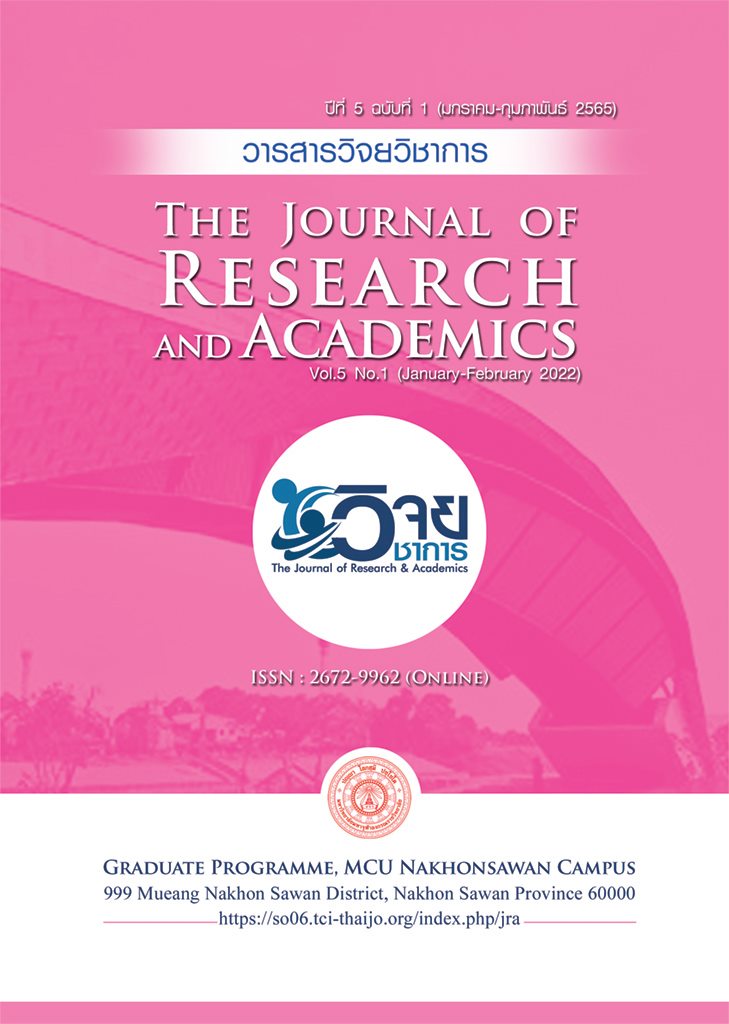การศึกษาอิทธิพลข้ามระดับของภาวะผู้นำเชิงวิสัยทัศน์ของผู้บริหารต่อความสัมพันธ์ระหว่างภาวะผู้ตามและการรับรู้บรรยากาศองค์กร ของอาจารย์ผู้สอน คณะพยาบาลศาสตร์ สถาบันการศึกษาเอกชน
Main Article Content
บทคัดย่อ
บทความวิจัยมีวัตถุประสงค์เพื่อ 1) พัฒนาโมเดลสมการโครงสร้างพหุระดับ อิทธิพลข้ามระดับของภาวะผู้นำเชิงวิสัยทัศน์ของผู้บริหาร มีความสัมพันธ์ต่อภาวะผู้ตามและการรับรู้บรรยากาศองค์กร ของอาจารย์ผู้สอน คณะพยาบาลศาสตร์ สถาบันการศึกษาเอกชนและ 2) ศึกษาอิทธิพลข้ามระดับของภาวะผู้นำเชิงวิสัยทัศน์ของผู้บริหาร มีความสัมพันธ์ต่อภาวะผู้ตามและการรับรู้บรรยากาศองค์กร ของอาจารย์ผู้สอน คณะพยาบาลศาสตร์ สถาบันการศึกษาเอกชน ประชากร คือ อาจารย์และผู้บริหารคณะพยาบาลศาสตร์ สังกัดสถาบันอุดมศึกษาเอกชน โดยกำหนดจำนวนตัวอย่างในการวิเคราะห์พหุระดับโดยใช้โปรแกรม Optimal Design ได้กลุ่มตัวอย่างผู้บริหารสถาบันและอาจารย์ จำนวน 20 สถาบัน มีผู้บริหารเป็นตัวแทนจำนวน 95 ตัวอย่าง อาจารย์ จำนวน 605 ตัวอย่าง เครื่องมือที่ใช้ในการวิจัยเป็นแบบสอบถาม จำนวน 2 ฉบับ ได้แก่ ผู้บริหารสถาบัน และอาจารย์ ผลการวิจัย พบว่า 1) โมเดลสมการโครงสร้างพหุระดับอิทธิพลข้ามระดับสอดคล้องกลมกลืนกับข้อมูลเชิงประจักษ์ และโมเดลสมการโครงสร้างพหุระดับภาวะผู้ตามและการรับรู้บรรยากาศองค์กรของอาจารย์ของอาจารย์ผู้สอนมีความสอดคล้องกับข้อมูลเชิงประจักษ์ โดยภาวะผู้ตาม เท่ากับ c2 = 3.864, df = 2, p-value = 0.145, RMSEA = 0.039, CFI = 0.996, TLI = 0.978, SRMR ของ Within = 0.001 และ ของBetween = 0.064 และการรับรู้บรรยากาศองค์กรของอาจารย์เท่ากับ c2 = 2.773, df = 2, p-value = 0.06, RMSEA = 0.054, CFI = 0.996, TLI = 0.978, SRMR ของ Within = 0.001 และของ Between = 0.014 2) อิทธิพลคงที่ โดยภาพรวมเฉลี่ยทุกสถาบัน ภาวะผู้นำเชิงวิสัยทัศน์ของผู้บริหาร ไม่มีอิทธิพลต่อภาวะผู้ตามและการรับรู้บรรยากาศองค์กรของอาจารย์ผู้สอน เมื่อพิจารณาอิทธิพลสุ่มพบว่า แต่ละสถาบันมีอิทธิพลแตกต่างกันอย่างมีนัยสำคัญทางสถิติที่ระดับ .01 และ 3) ภาวะผู้นำเชิงวิสัยทัศน์ของผู้บริหารไม่มีอิทธิพลกำกับต่อความสัมพันธ์ระหว่างภาวะผู้ตามและการรับรู้บรรยากาศองค์กร
Article Details

อนุญาตภายใต้เงื่อนไข Creative Commons Attribution-NonCommercial-NoDerivatives 4.0 International License.
1. เนื้อหาและข้อมูลในบทความที่ลงพิมพ์กับวารสารวิจยวิชาการ ถือเป็นข้อคิดเห็น และความรับผิดชอบของผู้เขียนบทความโดยตรงซึ่งกองบรรณาธิการวารสารไม่จำเป็นต้องเห็นด้วย หรือร่วมรับผิดชอบใด ๆ
2. บทความ ข้อมูล เนื้อหา รูปภาพ ฯลฯ ที่ได้รับการตีพิมพ์ในวารสารวิจยวิชาการ ถือเป็นลิขสิทธิ์ของวารสารวิจยวิชาการ หากบุคคลหรือหน่วยงานใดต้องการนำทั้งหมดหรือส่วนหนึ่ง ส่วนใดไปเผยแพร่ต่อหรือเพื่อการกระทำการใด ๆ จะต้องได้รับอนุญาตเป็นลายลักษณ์อักษรจากวารสารวิจยวิชาการก่อนเท่านั้น
เอกสารอ้างอิง
กมลรัตน์ เทอร์เนอร์และคณะ. (2555). คุณภาพชีวิตการทำงานและปัจจัยที่เกี่ยวข้อง ของอาจารย์พยาบาลเครือข่ายภาคกลาง 1 สถาบันพระบรมราชชนก. วารสารพยาบาลกระทรวงสาธารณสุข, 25(3), 184-198.
กระทรวงศึกษาธิการ สำนักงานเลขาธิการสภาการศึกษา. (2560). แผนการศึกษาแห่งชาติ พ.ศ. 2560-2579. กรุงเทพฯ: สำนักงานเลขาธิการสภาการศึกษา.
กุลธิดา กรมเวช .(2558). ความมุ่งมั่นทุ่มเทในการทำงานของพนักงาน: ปัจจัยที่เกี่ยวข้องและการพัฒนา. วารสารการพัฒนาทรัพยากรมนุษย์และองค์การ, 7(2), 87-103.
ฉวีวรรณ เอี่ยมพญา .(2559). บรรยากาศองค์การที่ส่งผลต่อคุณภาพชีวิตการทำงานของครูในโรงเรียน สังกัดสำนักงานเขตพื้นที่การศึกษามัธยมศึกษา เขต 8. (วิทยานิพนธ์ศึกษาศาสตรมหาบัณฑิต สาขาวิชาบริหารการศึกษา). บัณฑิตวิทยาลัย: มหาวิทยาลัยศิลปากร.
ชุลีพร เพ็ชรศรี. (2557). คุณลักษณะของผู้ตามและบรรยากาศองค์กรที่มีอิทธิพลต่อประสิทธิภาพ การปฏิบัติงานของพนักงาน กรณีศึกษา กลุ่มธุรกิจเทคโนโลยีสารสนเทศและการสื่อสาร. (วิทยานิพนธ์ปริญญาบริหารธุรกิจมหาบัณฑิต สาขาวิชาการบริหารทั่วไป). มหาวิทยาลัยราชมงคลธัญญบุรี: คณะบริหารธุรกิจ.
ดุษฎี โยเหลา. (2556). การศึกษาการจัดการเรียนรู้แบบ PBL ที่ได้จากโครงการสร้างความรู้เพื่อสร้าง เสริมทักษะแห่งศตวรรษที่ 21 ของเด็กและเยาวชน: จากประสบการณ์ความสำเร็จของโรงเรียนไทย. กรุงเทพฯ: หจก.ทิพยวิสุทธ์.
นงลักษณ์ วิรัชชัย. (2535). การวิเคราะห์ประมาณค่าส่วนประกอบความแปรปรวน (Analysis of Variance Component Estimation). ข่าวการวิจัย, 15(4), 9-14.
นิกัญชลา ล้นเหลือ. (2554). โมเดลสมการโครงสร้างภาวะผู้นำเชิงวิสัยทัศน์ของผู้บริหารสถานศึกษาขั้นพื้นฐาน. (วิทยานิพนธ์ปรัชญาดุษฎีบัณฑิต สาขาวิชาการบริหารการศึกษา). บัณฑิตวิทยาลัย: มหาวิทยาลัยขอนแก่น.
เนตร์พัณณา ยาวิราช. (2556). การจัดการสมัยใหม่. กรุงเทพฯ: ทริปเพิ้ล กรุ๊ป.
บุญชม ศรีสะอาด และสุริทอง ศรีสะอาด. (2552). การวิจัยเกี่ยวกับการบริหารการศึกษา. กรุงเทพฯ: สุวิริยาสาส์น.
ประเวศน์ มหารัตน์สกุล. (2554). องค์การและการจัดการ. กรุงเทพฯ: ปัญญาชน.
วิจิตร ศรีสุพรรณ. (2555). การเตรียมความพร้อมของวิชาชีพการพยาบาลเพื่อเข้าสู่ประชาคมอาเซียน. วารสารสภาการพยาบาล, 27(3), 1-10.
สิมาภา จันทร์หอมกุล. (2553). ความสัมพันธ์ระหว่างการรับรู้บรรยากาศองค์การความผูกพันในงาน และความพึงพอใจในชีวิตของบุคลากร สังกัดกรมสารบรรณทหารบก. (งานวิจัยส่วนบุคคลศิลปศาสตรมหาบัณฑิต สาขาวิชาจิตวิทยาอุตสาหกรรมและองค์การ). คณะศิลปศาสตร์: มหาวิทยาลัยธรรมศาสตร์.
สุขุม มูลเมือง และคณะ. (2561). เอกสารประกอบการสอนสถิติขั้นสูงเพื่อการวิจัยทางสังคมศาสตร์และทางการศึกษา การวิเคราะห์พหุระดับ การประยุกต์ใช้โปรแกรม Mplus. กรุงเทพฯ: มหาวิทยาลัยกรุงเทพธนบุรี.
สุขุม มูลเมือง. (2558). โมเดลสมการโครงสร้าง: การประยุกต์ใช้โปรแกรม AMOS และ Mplus. กรุงเทพฯ: มหาวิทยาลัยกรุงเทพธนบุรี.
สุภาวดี นพรุจจินดา.(2553). องค์ประกอบภาวะผู้นำของผู้บริหารวิทยาลัยพยาบาล สังกัดกระทรวงสาธารณสุข. วารสารการบริหารการศึกษา มหาวิทยาลัยศิลปากร, 1(2), 14-27.
อภิพงศ์ โชติรัตน์. (2557). การรับรู้บรรยากาศองค์การที่ส่งผลต่อความผูกพันในการทำงานของพนักงานย่านอโศก กรุงเทพมหานคร. (การค้นคว้าอิสระบริหารธุรกิจมหาบัณฑิต). บัณฑิตวิทยาลัย: มหาวิทยาลัยกรุงเทพ.
Beare, H. et. al. (1987). Creating an Excellent School: Some New Management Techniques. London: Rutledge.
Davis, K. (1981). Human Behavior at Work: Organizational Behavior. (6th ed.). New York: McGraw-Hill.
Heck, R. H., & Thomas, S. L. (2015). Quantitative methodology series.An introduction to multilevel modeling techniques: MLM and SEM approaches using Mplus. (3rd Edition). New York: Routledge.
Huczynski, A., & Buchanan, D. A. (2013). Organizational behavior. (8th edition). Harlow: Pearson.
Jeffrey, S. (2016). 10 Attributes of Visionary Leadership. Retrieved from https://www. scottjeffrey.com/visionary-leadership
Kanten, P. and Ülker, F. (2013). The Effect of Organizational Climate on Counterproductive Behaviors: An Empirical Study on the Employees of Manufacturing Enterprises. The Macrotheme Review, 2(4), 144-160.
Kelloway, E. K. (2015). Using mplus for structural equation modeling; A researcher's guide. Thousand. Oaks: Sage Publications.
Madelyn Jessica Stoner-Zemel. (2014). Visionary leadership, management, and high performing work units: an analysis of workers ' perceptions. (Doctoral Dissertations, Degree Program is Education). Graduate School: University of Massachusetts Amherst.
Nair, A. (2006). Meta-Analysis of the Relationship between Quality Management Practices and Firm Performance-Implications for Quality Management Theory Development. Journal of Operations Management, 24(6), 948-975.
Nanus, B. (1992). The Leader's edge: The seven keys to leadership in a turbulent world. Chicago, IL: Contemporary Books.
Spencer, L. M., & Spencer, S. M. (1993). Competence at Work: Model for Superior Performance. New York: Wiley & Sons.
Zigarmi, D., Houson, D., Witt, D., & Diehl, J. (2011). A Preliminary Field Test of an Employee Work Passion Model. Human Resource Development Quarterly, 22(2), 195-221.


